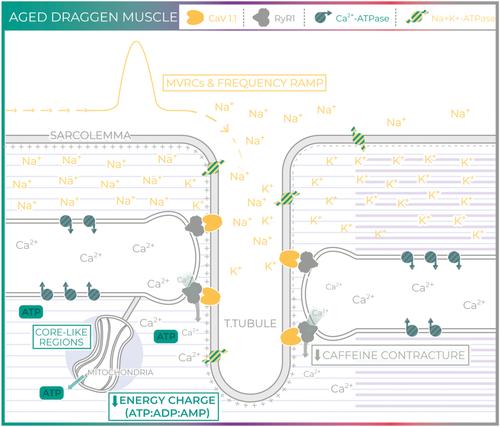衰老有助于周期性麻痹小鼠模型的表型转变
引用次数: 4
摘要
周期性麻痹(PP)是一种罕见的遗传性疾病,其中离子通道突变引起与高或低钾血症相关的发作性麻痹。PP的一个无法解释但一致的特征是,在40岁左右发生表型转变,钾诱导的肌肉无力的严重程度下降,但有报道称出现固定的进行性无力。这种表型转变与健康个体的肌肉质量和最佳运动功能开始下降的年龄相吻合。我们试图确定PP的表型转变是否与正常衰老表型转变有关,并探索其中的机制。方法将高钾血症性PP小鼠模型与野生型仔鼠在13 ~ 104周龄范围内进行比较。由于在雌性小鼠中外显率不完全,因此仅使用雄性小鼠。我们采用人体肌肉速度恢复周期技术来检测小鼠体内肌肉兴奋性。然后,我们使用离体肌肉张力测试检查钾诱导的虚弱或咖啡因挛缩力随年龄的变化。通过Western blot、组织学或能量电荷测量进一步表征肌肉。对于正态分布的数据,采用学生t检验(±Welch校正)或单、双向方差分析(ANOVA)来确定显著性。对于非正态分布的数据,采用Welch秩检验、Mann Whitney U检验或Kruskal-Wallis方差分析。当方差分析具有显著性时(P <0.05),采用事后Tukey检验。结果随着年龄的增长,WT (P = 0.009)和PP (P = 0.007)肌肉对钾诱导的无力的抵抗力均有所增强。我们的数据表明,尽管肌层去极化和钠通道失活,健康的老年肌肉仍发展出维持力量的机制。相比之下,咖啡因降低的收缩力(P = 0.00005)、骨骼肌能量电荷(P = 0.004)和结构核心病理(P = 0.005)是Draggen肌所特异性的,这表明它们是由慢性遗传离子通道功能障碍引起的,或至少是由慢性遗传离子通道功能障碍加速的。结论随着年龄增长的表型转变在小鼠PP模型中被复制。内在肌肉老化对钾诱导的HyperPP小鼠虚弱有保护作用。然而,它似乎也加速了肌浆网钙释放的损伤、线粒体损伤和核样区域的发展,这表明获得性RyR1功能障碍是潜在的病因。这项工作首次描述了PP中随年龄变化的表型转变机制。它还证明了如何研究单基因疾病中随年龄变化的表型转变可以对疾病生理学和衰老过程本身产生新的见解。本文章由计算机程序翻译,如有差异,请以英文原文为准。

Ageing contributes to phenotype transition in a mouse model of periodic paralysis
Periodic paralysis (PP) is a rare genetic disorder in which ion channel mutation causes episodic paralysis in association with hyper‐ or hypokalaemia. An unexplained but consistent feature of PP is that a phenotype transition occurs around the age of 40, in which the severity of potassium‐induced muscle weakness declines but onset of fixed, progressive weakness is reported. This phenotype transition coincides with the age at which muscle mass and optimal motor function start to decline in healthy individuals. We sought to determine if the phenotype transition in PP is linked to the normal ageing phenotype transition and to explore the mechanisms involved.
求助全文
通过发布文献求助,成功后即可免费获取论文全文。
去求助

 求助内容:
求助内容: 应助结果提醒方式:
应助结果提醒方式:


